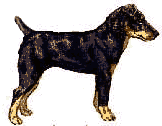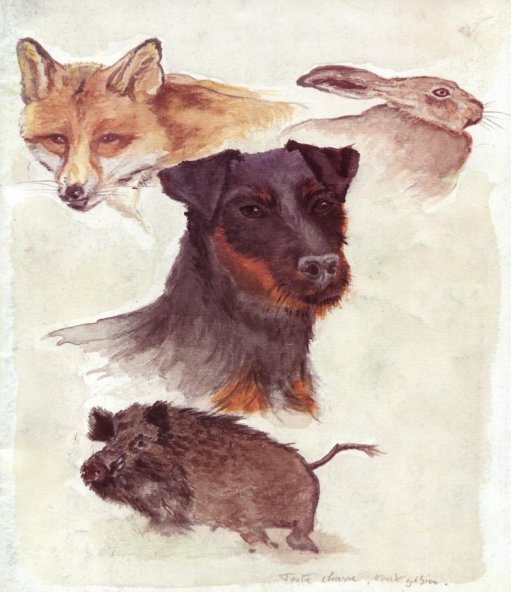|
Home Ozzy Ozzy
  
HISTORY
The Jagdterrier (German Jagdterrier, Deutscher Jagdterrier, German Hunt
Terrier) is a comparatively young breed, having been developed only since the
turn of the 20th century. The breed was developed in
Germany
as a functional hunting dog, and is used there on a wide variety of game,
including wild boar, badger, fox and weasel. Imports into the
United States
and
Canada
have also been used by sportsmen as tree dogs, primarily for raccoon and
squirrel.
The
Jagdterrier was recognized by the United Kennel Club on
January 1, 1993 .
GENERAL
APPEARANCE
The Jagdterrier is first and foremost a hunting and sporting dog. Jagdterriers
possess a spirit of liveliness and speed at work, yet are regal at rest. "Alert'
"athletic" and "active" describes the ambience of the Jagdterrier. A bit of
fire is always evident in its expression.
Physically,
individuals should exhibit a square (though not broad) build, standing squarely
and true over the feet. A deep and narrow chest allows the dog to more easily
enter dens, and is preferred, while an excessively wide chest lessens this
ability. Leg length is in proportion to the rest of the body, avoiding both
stubbiness or legginess. The tail is set fairly high and straight, and is gaily
carried. The tail posture, while the dog is working, will be wayward and is not
important. Though cropped, the remaining tail must be long enough to serve as a
handle, should the hunter need to pull the terrier from a den. The coat may be
either harsh or smooth, the important factor for coats of working terriers being
that the coat must be thick and ample for turning briars and fangs.
All
deviations from the standard that would affect the working ability of an earth
dog are penalized in direct relation to their deviation.
Scars, the
result of honorable wounds, are not considered faults and are not to be
penalized.
CHARACTERISTICS
This terrier breed is a clever hunter, unrelenting, tough, robust and
unafraid of the most formidable wild game; and very intent in the pursuit of
such game. The breed is highly intelligent and affable with its master and other
hunters. Considering its determination to work, and its combustible energy, the
breed should not be selected strictly as a pet, though they are totally people
friendly.
Dash,
gameness and pluck are all descriptive of a properly bred Jagdterrier. The
Jagdterrier, bred solely by hunters over its existence, has maintained the
fearless characteristics of early day den terriers.
HEAD AND
SKULL
The skull is flat and wider between the ears than the Fox Terrier's, tapering
between the eyes. The stop is slight. The length of the muzzle, from the stop to
the tip of the nose, is shorter than the distance from the occiput to the stop.
The powerful muzzle has pronounced cheeks; there must be nothing of the
Greyhound in the muzzle. The strong lower jaw has a well-chiseled chin.
TEETH
A full complement of strong, white teeth meet in a scissors bite.
Serious faults: Absence of premolars. Overshot bite. Undershot bite.
EYES
The small, dark eyes are deep‑set and have a determined expression. The eyelids
are close-fitting.
NOSE
The nose is black, unless the dog's main color is brown, when a brown nose
is acceptable.
Serious faults: Light-colored nose. Spotted nose.
EARS
The v-shaped ears are not too small. They are set on high and carried
lightly against the side of the head. The ears must be of adequate thickness to
withstand work in briars and thickets.
Serious faults: Erect, tulip or rose ears. Thin, easily torn ears.
NECK
The strong, rather-archad neck is not excessively long. It broadens at the
point of insertion into the shoulders.
FOREQUARTERS
The shoulders are long and sloping.
FORELEGS
The straight forelegs are well‑muscled. The bone is strong rather than fine. The
pasterns are slightly slanted and flexible.
Serious fault: Steep shoulders.
BODY
The deep and narrow chest, to have room for heart and lungs, must have depth
and well-arched ribs. The straight back is strong but not short. The loins and
croup are strongly muscled.
Serious faults: Short back and wide chest, which encumbers passage
through narrow, winding den tunnels.
HINDQUARTERS
The muscular hindquarters are well‑angulated. The bone is strong.
HIND- LEGS
The thighs are long. The hocks are well let down.
Serious fault: Lack of angulation.
FEET
The well‑knit feet are oval in shape. The front feet are frequently larger
and wider than the hind feet. Cat‑type feet are not acceptable.
TAIL
The tail is usually docked, leaving about 5/8 of the original length. (It is
better to take off too little than too much.) The tail must serve as a handle
for hunters to pull the terriers from the dens.
The tail is
normally carried gaily in the manner of a foxhound, but also reflects a
terrier's mobility, and can be in any posture while the terrier works.
COAT
Both smooth and harsh coats, or any texture in between, are acceptable, but the
coat must be thick and abundant to turn briars, dampness and cold.
Serious faults: Fine, silky‑soft or short coat unsuitable for the rigors of a
working terrier. Woolly hair. Open coat. Lack of hair on the belly.
COLOR
The main body color may be black, black and gray, or dark brown; with brown,
red, yellow or lighter colored markings found on the eyebrows, chest, legs and
anus. Both light and dark colored masks are acceptable.
A small
amount of white on the chest and toes is acceptable.
HEIGHT AND
WEIGHT
Because they are den dogs, Jagdterriers must not be too large to enter a
varmint burrow nor too small to defend themselves in a confrontation with their
quarry.
Height,
measured at the withers, must not be less than thirteen (13) inches nor greater
than sixteen (16) inches.
The ideal
working weight should not be under sixteen (16) pounds nor over twenty‑two (22)
pounds; the bitch being generally lighter than the dog.
GAIT
Terriers were often required to run with the hounds, being there to bolt the
quarry should it go to ground. Thus, their gait is more gallop than trot. This
requirement remains for the Jagdterrier. They should have galloping power and
the tendency to a smooth gallop at fair speed when at liberty.
DISQUALIFICATIONS
Unilateral or bilateral cryptorchid. Extreme viciousness
or shyness. Poor hunting desire or ability.
Reproduced with the permission
of the United Kennel Club
| 